Polymer sewer hatches: types and characteristics + features of use
Practical polymer sewer hatches, despite the fact that they were presented to consumers relatively recently, have already gained popularity, as they are able to effectively cope with all necessary tasks. In addition, they have a rather attractive appearance and an affordable price.
But in many ways the final result depends on the correct choice, so you need to know the main performance characteristics of polymer products. In this article, we will consider in more detail the features of plastic lids, the main types, marking features and recommendations for their use.
The content of the article:
Purpose and types of hatches
Hatches made of polymer materials are no less in demand than their cast iron counterparts. Moreover, in some cases, polymer products are most suitable. For example, for arrangement of a sewer well in the country.
Regardless of appearance, weight, shape, color and other characteristics, all specified equipment is designed to solve the same problems, which include:
- ensuring the safety of the movement of pedestrians and any vehicles - that is, with the help of hatches, injuries and accidents should be excluded;
- protection of elements of engineering communications, wells in which they are located from clogging, damage by objects falling inside;
- preventing theft of parts of utility lines and hatches themselves.
The appearance of the product also plays an important role - most buyers select polymer lids that have high aesthetic properties.
As for the manufacturing material used in the production of plastic sewer manholes, it is represented by several types of polyethylene:
- secondary high pressure;
- low pressure containing modifying additives.
Hatches are made by pressing components heated to 300 °C.
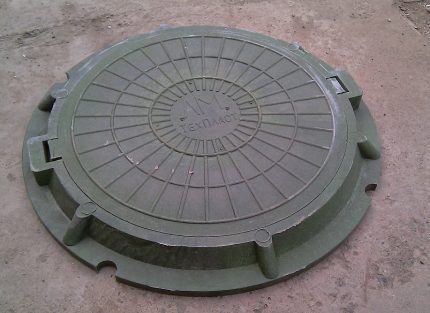
In addition to plastic ones, the category of polymer hatches includes products that contain other additives. These are polymer-sand, rubber and composite.
The composition of polymer-sand products includes 70% clean and dry sand, and the remaining 30% is LDPE and HDPE plastic. This composition provides the finished lid with good strength, resistance to aggressive substances and temperature changes.
They are also produced by hot pressing at temperatures above 100 degrees.
Rubber is reinforced with nylon thread and wear-resistant sewer covers are made from these materials.
A composite or premix is a mixture of polyester resin, fiberglass, calcite and other additives used according to the manufacturer's recipe.
We wrote more about the materials for manufacturing hatches and their features Here.
Features of plastic hatches
Hatches are made to solve the same global problems, but there are many of their subtypes, which affects their design features, strength, cost and a number of other characteristics.
As a result, polymer products are beginning to be divided into varieties, which are influenced by: functional purpose and dimensions.
Functional application and dimensions
So, according to the profile GOST, there are the following types of polymer products:
- Lightweight small-sized hatch, abbreviated as LM;
- Light hatch or just L.
Most often, the first category of products is dealt with by the owners of private houses, plots on which communications are laid, and they are encountered by visitors to parks. The reason is that lightweight, compact small hatches are designed for pedestrian and green areas.

They meet the requirements of load class A15, which means that they can withstand the weight of even a truck. But nevertheless, if these are one-time attacks, and not systemic ones, and over a long period of time.
According to GOST, any such hatch must:
- withstand at least 1500 kg load or 15 kN;
- have a diameter of 450 mm.
The seating depth in the shell should not be less than 20 mm; this is necessary in order to exclude the possibility of the hatch spontaneously leaving its seat under some unusual circumstances, for example, from a gust of strong wind.
The lightweight hatch is designed to perform the same tasks as its lightweight, compact counterpart. But it has a larger diameter - from 550 mm.
From various sources you can glean information that polymer hatches can withstand much greater loads than indicated above.
This may be true, but the profile GOST in the section devoted to the materials of hatch covers and bodies contains requirements stating that plastic can only be used for the manufacture of the above listed products.
The list of materials from which hatches can be made includes cast iron, the same metal, but with concrete inserts, and polymers. The father-in-law says nothing about sand bonded with plastic in GOST.
As a result, the use of any plastic hatches will not be entirely legal and may entail sanctions, especially if some kind of incident occurs because of them.
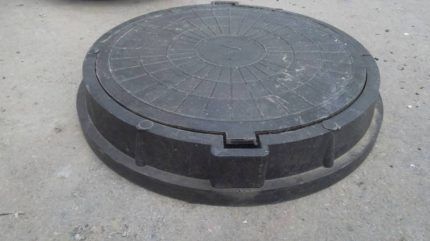
The above is also true for polymer-sand products. As for composite covers, they, according to sellers and manufacturers, can withstand an impressive 25 tons of load.
And this statement is true. True, their cost is higher than their plastic counterparts.
Regardless of the variety, each lid should have a relief of 10-70% of the entire surface. In addition, all of them must fit freely into the housings. In this case, the gap between both parts of the structure should not exceed 3 mm.
And the hatches must fit tightly to the supporting parts of their hulls. So the tolerance should not exceed 2 mm.
Nuances of marking polymer hatches
Each polymer product can belong not only to the category of hatches, but also to other products. For example, to be a storm drain, a repair insert.
And to avoid any misuse that is fraught with negative consequences, each such product must be marked by the manufacturer.
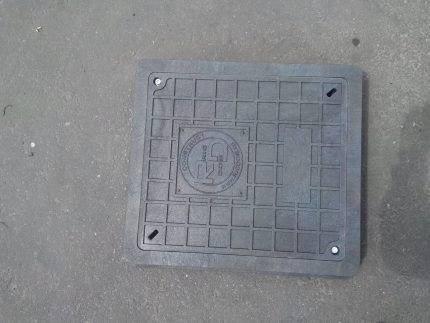
That is, according to the current GOST, the word is indicated on cases and covers:
- "Luke";
- "rain water inlet";
- "insert".
The manufacturer's mark must confirm such information. It is also important that you cannot mix parts for different purposes.
In addition, each hatch must have a date of manufacture. Since the polymer has a shelf life (usually 20 years), after which it begins to noticeably lose its qualities, and the accompanying documents are unlikely to be preserved during this time, the GOST requirements for this moment are quite stringent.
Therefore, without a stamp with the month and year of manufacture, the hatch will be non-standard.
Shape and dimensions of covers
In addition, the division of plastic products can be carried out according to a number of other characteristics.
Which include:
- form;
- dimensions;
- availability of additional equipment;
- decorative qualities.
So on sale you can find plastic equipment of different shapes - round, square, rectangular.
Although the industry is ready to supply anything, it should be remembered that according to the rules set out in GOST, only round hatches are considered standard.
The reason is that they are the safest. So, this form will not allow the product to fall down, and not in one position; it can better withstand some types of load.
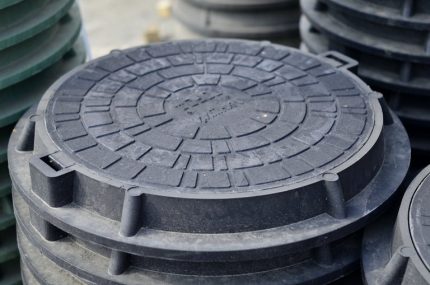
All other subspecies are not prohibited, but it is advisable to use them exclusively in places where they cannot lead to injury or other troubles.
Dimensions of round plastic hatches for sewer and other wells are listed in GOST (they are listed above). In all other cases, manufacturers act at their own discretion, since the dimensions of square and other products are not regulated.
But the practice has developed when the length of the sides ranges from 30 cm to a meter, with the pitch usually being 50 mm.
Availability of additional equipment
Polymer products can be standard or equipped with various devices to solve certain problems.
So additional equipment may include:
- constipation, which prevent hatches from being blown away by the wind and being displaced by car wheels;
- locks, excluding vandal and illegal actions, for example, theft.
In addition, hatches are often equipped with openings for dismantling, preventing the accumulation of gases and other equipment.
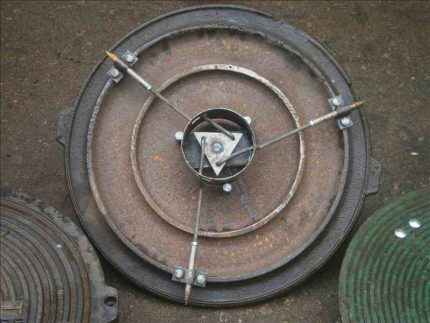
Decorative qualities of products
Manufacturers, taking into account the tastes of different categories of consumers, supply the market with products that have high aesthetic qualities.
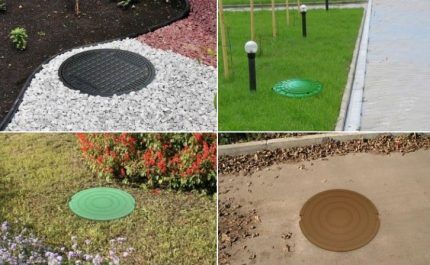
Which provide:
- Color selection. Today, a plastic cover of any sewer or other type of manhole can shine with almost all the colors of the rainbow. This allows you to present such a product in a favorable light or disguise it.
- Corrugation pattern, font type. GOST allows manufacturers to choose the design of the manhole cover themselves, which, together with the color, gives a positive effect and variety.
Modern polymers are not affected by temperature changes, do not fade, and do not delaminate. This significantly improves the decorative qualities of the lids and maintains their appearance in their original condition for several decades.
Thus, a practical lid made of polymer material will serve its purpose for decades, closing manhole or plastic sewer well, or another well in the country where utilities are located, and after 20 years you can buy a new one and, thanks to its light weight, easily replace it with your own hands.
Conclusions and useful video on the topic
The video below will allow you to better understand the capabilities of polymer hatches. By the way, it is worth paying attention to checking the product under pressure, since according to the relevant GOST, the procedure must be carried out before sale.
Polymer hatches are modern and quite practical products that can make the life of users more comfortable. In addition, they have high performance, durability and affordable cost..
But their capabilities, in comparison with their cast iron counterparts, are still limited. Therefore, when choosing, you should be vigilant and not overestimate their capabilities, so as not to incur financial losses.
Are you selecting a plastic hatch for arranging a sewer well in your country house and want to clarify a couple of points regarding your choice? Ask your questions under this publication - our experts and other site visitors will try to help you.
Or maybe you recently purchased polymer roofs, installed them yourself and now want to share your experience with newcomers to this business? Tell us about the models you have chosen to suit your needs, add photos of installed hatches below under our article.




As for me, the only advantage of plastic hatches is their light weight. I don’t even consider the variety of colors to be a particular advantage, because a cast-iron hatch, after all, can be painted. I have always liked cast iron hatches, they are so authentic, there is something about them that attracts more. But lately I’ve been coming across plastic options more and more often. And all because cast iron ones are to this day mercilessly dragged by all and sundry. Apparently, plastic everywhere is our future, alas(((
If we talk about the use of such hatches for private areas, then light weight is not a minus, but very much a plus. For my dacha I bought a polymer sewer hatch for the drainage pit. It’s only the first year so far, so I won’t make any predictions, but now I haven’t noticed any downsides at all. Well, the fact that plastic is used everywhere - so what difference does it make if the quality is appropriate?
We have 2 large holes behind our house, they are very deep, like wells.The iron hatches were closed all the time, but recently these hatches began to be stolen. The street is poorly lit and now the pits are open. Zhek doesn’t care about this. I wrote a statement, to no avail. And the children walk around as if nothing had happened. So I’m thinking on my own initiative to buy a polymer hatch and close the hole. Do you think it will be reliable enough? If a car passes, will it crack?
Perfect solution. A polymer hatch is not only inexpensive (600-800 rubles) compared to a cast iron hatch (from 3,500 rubles), but also quite reliable. Even the simplest polymer hatch can withstand loads of at least 1.5 tons. There are models that can withstand up to 30 tons. I recommend that you purchase a reinforced hatch that can withstand a load of at least 3 tons. Such a product will contain the marking LMU or L. The recommended hatch size is 750*110.
Tell me how to install a polymer hatch on a steel well, and how is the tightness of such a connection ensured?
What paint/primer should I use?